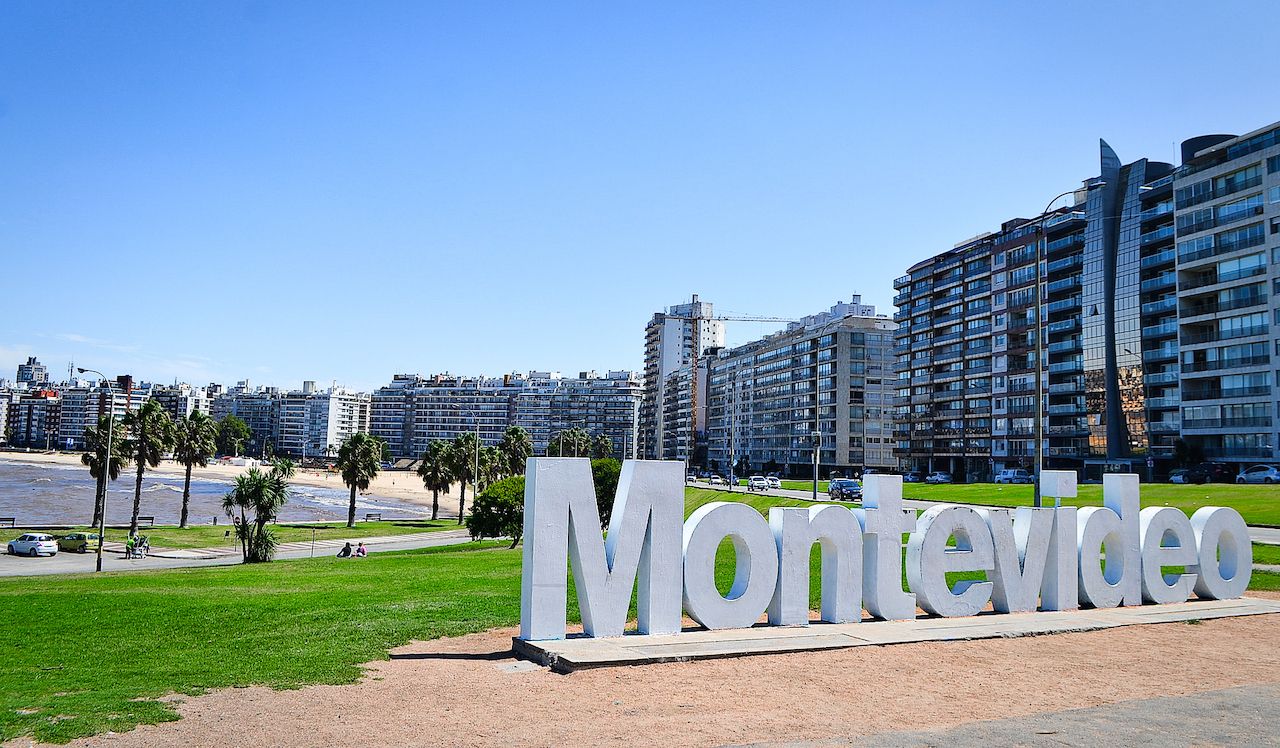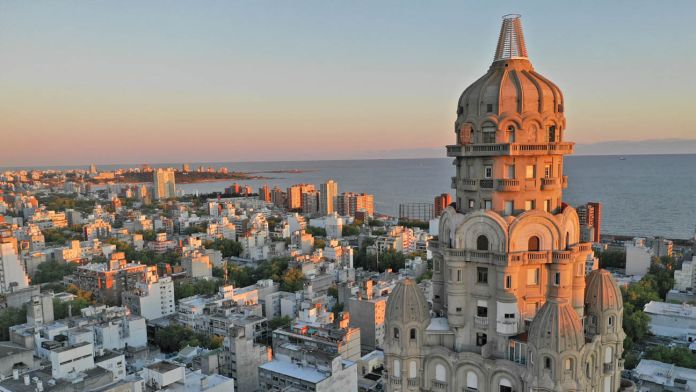Like many countries that colonizers landed in, the country name of Uruguay is derived from the Spanish trying to pronounce Guarani names. Historical linguists are kind of torn between whether it comes from the word urú (meaning “wild fowl” in general) or from uruguá (referring to a type of snail that was common near the rivers there). During the colonial times under the Spanish, this area was known as Cisplatina or as Banda Oriental del Uruguay, or the Eastern Bank of the Uruguay [River]. Today, it’s officially called the República Oriental de Uruguay.
Uruguay is located in southern South America, nestled right in between Brazil and Argentina and sharing a coast along the South Atlantic Ocean. The southern border of the country is at the mouth of the Rio de la Plata, which turns into the Uruguay River and eventually winds its way around to the north to become the border between the Brazilian state of Rio Grande do Sul and Argentina and then between Rio Grande do Sul and the state of Santa Catarina. Uruguay is the second smallest country in South America, after Suriname. Montevideo narrowly beats out Buenos Aires to be the southernmost capital city in the Americas and only third-most southern in the world (after Canberra and Wellington). Because of its location, Uruguay also has a fairly temperate climate and generally uniform temperatures across the country. However, because of the lack of a mountainous natural barrier, they are subject to the winds that come down from the mountain ranges in Argentina.
The first people who lived in this area were the Charrúa tribes, which were largely the victims of genocide by the Spanish when they arrived. In fact, their languages are in danger of completely dying out, if it hasn’t done so already. The Portuguese were technically the first to arrive in this area in 1512, and the Spanish arrived nearly four years later. The two countries argued over who controls it, each building their own settlements along the rivers. Montevideo was founded in the early 1700s as a competition to Buenos Aires (which are only about 150 mi apart). While the Spanish and Portuguese were still arguing over who controls what in this area, the British (and others) got into this fight, too. In fact, the British tried to take these two cities as part of the Napoleonic Wars. Finally in 1811, José Gervasio Artigas led the charge to fight off the Spanish, which led to the creation of Banda Oriental (which consisted of Uruguay, all of the Brazilian state of Rio Grande do Sul, and some of the state of Santa Catarina). Then Portuguese forces took the territory and annexed it as Cisplatina, and as Brazil gained its own independence, they fought a war over this territory where there was no clear winner, and Britain stepped in to foster an agreement. Thus, Uruguay gained its own independence through this and split itself into two political parties: the Blancos (representing rural life) and Colorados (representing urban life). Argentina was quick to get involved in these conflicts between the two parties along with Britain, France, Italy, and Brazil. These conflicts would last throughout most of the 19th century, with military rule at a time too. Toward the turn of the century, they saw a rise in immigration as Montevideo was becoming an important port city. The first part of the 20th century was marked with changes in their political stability, economic strain from the Great Depression, and unrest from labor issues and government corruption, culminating in the 1960s-1980s a situation where Uruguayans were being kidnapped and killed by a CIA-backed operation aimed at so-called “controlling terrorism” in South America called Operation Condor (when it was really just aimed at offing opponents to the right-wing candidates/dictators). Since then, Uruguay has worked to rebuild their country and create a society that would go on to be one of the most socially progressive countries in the world.
 |
| Montevideo's La Rambla is a sidewalk that extends nearly 14 mi along the beachfront. |
The capital city is Montevideo, located on the southern coast of the country but on the northern bank of the Río de la Plata. The “monte” part of its name refers to the hill near the city for which it’s named, but there are some disputes on whether the Spanish or Portuguese named the city. With about 1.3 million people, around one-third of the population lives in the city. Considered a beta global city, Montevideo is a modern city in the midst of colonial architecture. It serves as the center for government, commerce, and transportation, and it has many theatres, galleries, restaurants, shopping centers and markets, beaches, museums, sporting venues, universities/schools, and parks.
Right around the turn of the 21st century, Uruguay went through a period of economic depression, related to the economic depression of Argentina. In 2005, Uruguay enacted a conditional cash transfer as a way to curb problems stemming from poverty, conditional on requiring kids to go to school and get health checkups, etc. Most of the land in Uruguay is used for agriculture: mainly cattle breeding, sheep and meat farming, dairy farms, and certain crops like rice. They are a large producer of beef, soybeans, wool, horsemeat, beeswax, and quinces. Tourism is also important to their economy, and recent social changes make it a choice destination. Especially since it’s LGBTQ+ friendly, and weed is legal throughout the country.
 |
| Iglesia de la Carmelitas in Montevideo |
While there is no official religion, nearly 58% of the population follows Christianity. And of those, Catholicism has the most followers (around 46%). Around 40% were unaffiliated with any particular religion (“I’m just spiritual”) or were atheist/agnostic. There are smaller numbers of Jewish followers, animists, and Umbandists (an Afro-Brazilian religion).
The national language of Uruguay is Uruguayan Spanish, which is similar to that of Argentina. It uses a few different forms not found in some other varieties of Spanish, like the voseo form. In some places along the border with Brazil, there are a small number of Uruguayan Portuguese speakers.
Although Montevideo is a major city, the country is largely rural, with about three-quarters of it covered by grasslands. In fact, there are more sheep there than people. That goes for cattle too: not only do they have about three cows per person, but they also keep track of close to 100% of their cattle. And as we watched our schools scramble to put together virtual learning plans and try to get enough laptops for everyone, Uruguay was giving every kid a laptop and WiFi connection back in 2007 -- the first country in the world to do this (and it was still only less than 5% of their national budget). We could’ve learned a thing or two.
Up next: art and literature





No comments:
Post a Comment